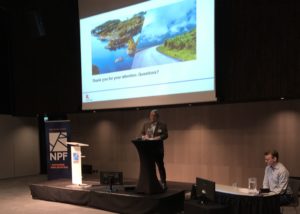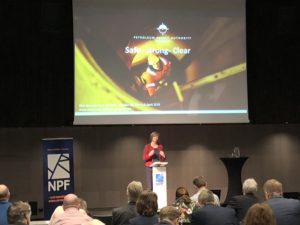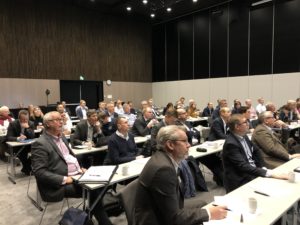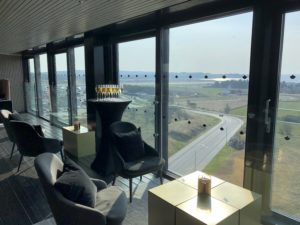Our keynote speaker was Bente Nyland, the director general at the Norwegian Petroleum Directorate. She described that the NCS was still attractive, and with new challenges ahead.
The auditor general Per-Kristian Foss presented the Auditor General’s audit of the PSA’s follow-up of HSE in the petroleum industry. He recommended more risk based verification that regulatory non conformities are rectified and that orders are complied with; that available sanction methods are used and escalated when necessary; development of methods to measure the effect of the PSA; and improved follow-up of cyber security.
Anne Myhrvold, director general of the PSA, discussed the PSA’s main message to the industry in 2019; “Safe – strong – clear”. She emphasized the industry’s duty to reduce risk, and how the PSA is strengthening the regime. She also presented the PSA’s risk management memo.
Professor Klaus Mohn, University of Stavanger, presented Norway’s Climate Risk Commissions report. He described the climate challenge as massive, and presented the commission’s description of risk factors, analysis and management recommendations.
Eyvind Aven, senior advisor Corporate Risk Equinor, presented Equinor’s method to better align Enterprise Risk Management and Balanced Scorecards. He gave examples that holistic ERM is necessary to avoid narrow and sub-optimal KPI focus. Dag Eggan, Senior Vice President Business Performance at OKEA, described operator transition and revitalization of the Draugen platform as a marginal field. Marginal fields are “normal discoveries” with large production value when realized through lean development solutions.
In our cyber security session, Lars Idland, Vice president IT, Chief Information Security Officer, Equinor, presented how Equinor manage cyber security risk; while Kenneth Titlestad, Manager-Cyber Security, Sopra Steria, presented vulnerabilities, attack trends and major accident risks. Key take aways were that current industrial systems are not resilient, risk is increasing, and there’s a need build future-proof barriers.
Camilla Nylund, Managing Director of Optilift, gave an example of innovation targeting both threats and opportunities, by how risks within offshore lifting and logistics can be reduced by utilizing AI.
Marit Blaasmo, VP D&W- Improvement & Performance, AkerBP, described AkerBP’s focus on value creation through “Performance First”, as a way to balance threats and opportunities in the Drilling and Well department. P&A at the Valhall field was used as an example of increased performance.
Tore Sagvolden, Principal Advisor, Lilleaker Consulting, presented the ongoing JIP “New methods for risk informed decision support in development projects”. The objective is to develop and concretize principles and ideas into methods, guidelines and a new common industrial practice. Highlights include replacing as-built QRAs in operations with barrier management. For standard designs, QRAs should be replaced by simplified assessments, and the focus should be on providing better decision support at the right time instead of detailed risk descriptions.
Ole Jørgen Melleby, Head of HSE Management Section, PSA described risk and change management to a digital world. He presented a report that concluded that cost cutting and poorly managed changes increase risk, and that risk can be reduced in these processes if managed well. He presented several keys to risk reduction.
Eirik Wærness, Senior Vice President and Chief Economist at Equinor, presented a view of energy outlooks and climate risks. He described large uncertainties, but that the global demand for energy is certainly growing. He described three different scenarios for economic growth, energy demand and energy intensity, and that attaining the 2 degree goal is possible but difficult, since only one of these scenarios meets this goal. He cautioned against wishful thinking, and instead highlighted risk management as a prerequisite for robust strategy development. This calls for making some scenario-dependent bets and avoiding having all eggs in one basket.





